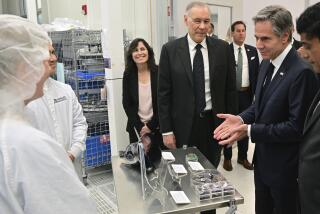Hitachi to Make VCRs at Its Anaheim Facility
- Share via
Hitachi Ltd., one of Japan’s largest conglomerates, said Monday that it will spend $1.5 million to remodel part of its Anaheim television plant for production of videocassette recorders.
The move, which accentuates Hitachi’s attempts to make its presence in the United States more than “cosmetic,” will make Hitachi the first company to produce VCRs in this country.
Manufacture of VCRs should begin by June with initial production of 100,000 units a year. The new operation will occupy a third of the plant operated by Hitachi Consumer Products of America, one of Hitachi’s 46 subsidiaries and units in the United States. The shift is expected to create about 50 new jobs, a company official said.
Production Predictions
Hitachi, which produces about 4.5 million VCRs annually and exports 60% of them to the United States and Canada, expects annual production at the Anaheim facility to reach 500,000 to 600,000 units in four to five years.
Hitachi has said previously that it wants to expand its limited manufacturing base here and become more “American”--an effort observers attribute largely to general trade tensions and Hitachi’s concern over its image. Hitachi has been named in several complaints against cheap imported computer chips and three years ago was caught stealing IBM trade secrets.
“Generally we are pleased when companies decide to invest in electronics production here in the United States,” said Robert Eckelmann, acting deputy assistant secretary for science and electronics with the Commerce Department’s International Trade Administration. “It’s something that has positive employment implications and helps to establish a stronger base of consumer electronics production in the U.S. We’re for it.”
While the investment is welcome, separate trade problems with Japan persist, he noted. U.S. electronics companies are having trouble getting access to Japanese markets. And in certain areas of competition, such as semiconductors, the Japanese have pricing practices that “do not conform to U.S. law,” he said.
Hitachi said it has other plans to increase its U.S. presence. It said that it is looking for a site here to make large-scale computer disk drives and that it will expand its semiconductor plant in Texas next year to make more sophisticated “semicustom” chips. Hitachi America said it will begin training Americans as “deputy general managers” within the year--a first for Hitachi’s U.S. units.
U. S. Components
Hitachi Consumer Products said its VCR operation will acquire about 10% to 20% of its components from U.S. sources in the initial years but will raise the local content ratio to more than 50% eventually.
Still, industry analysts questioned whether the Anaheim VCR production will be simply an assembly line or whether it will truly “manufacture” technology and add significant U.S. value to the completed product.
The initial local content will be mostly boxes and plastic covers, said Morihiko Koide, executive vice president of Hitachi Consumer Products. The electronics will be brought in from Japan.
“Frankly, I don’t know about the future plans (for more local content),” he said. The television production facility, which started in Compton in 1979, still imports its electronics package from Japan, relying on U.S. firms for picture tubes and the rest of the television parts, he said.
Koide explained that the company’s basic manufacturing philosophy is to build its products “at the closest point to the end user.”
Hopes It Will Take Root
The planned increase in local content is “assuring people that the product is not just assembled here with a stamp on it,” said Larry Kimbell, director of the UCLA business forecasting project.
“This sounds like a significant step, and I hope it will take root and not be here just because of a temporary threat of protectionism,” he said. “But then, the VCR workers of America have never complained about (the need for) protectionism--there aren’t any.”
Another analyst, however, was more skeptical of Hitachi’s moves.
“It sounds like a small initial local content--boxes and plastic covers--and just promises for the future,” said Brian Jeffrey, research director at the International Technology Group in Palo Alto. “It’s part of a trend right now. The whole electronics industry has seen one company after another open up in the United States. The real pressure is coming down from the United States on Japan and from Japan on Japanese manufacturers. It’s all to diffuse protectionist tensions.”
While getting 10% of its components from U.S. manufacturers will produce some benefit to U.S. suppliers, “the kinds of components they need are those that are not economically sound to ship from Japan--like plastic covers or boxes.”
More to Read
Inside the business of entertainment
The Wide Shot brings you news, analysis and insights on everything from streaming wars to production — and what it all means for the future.
You may occasionally receive promotional content from the Los Angeles Times.










